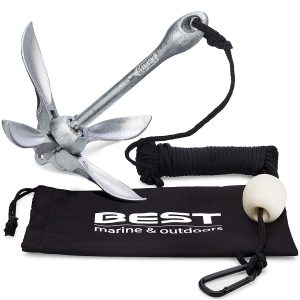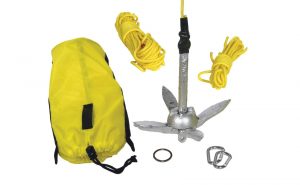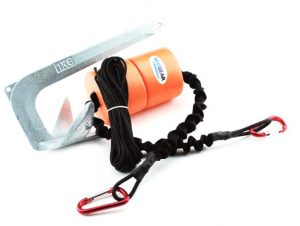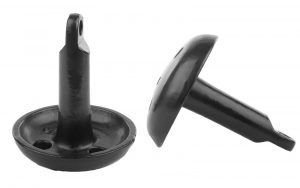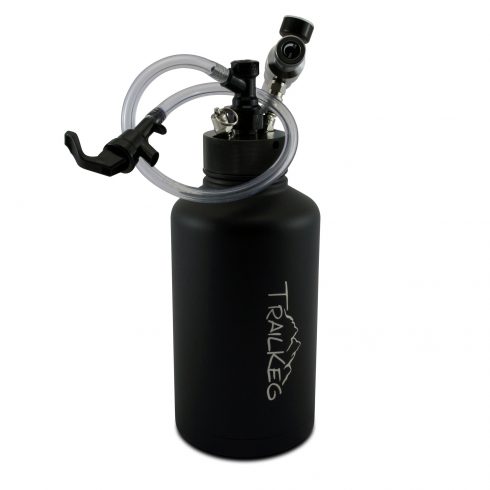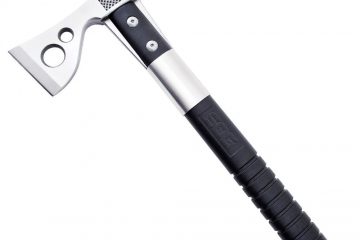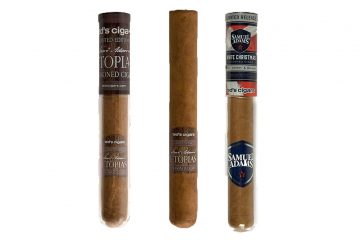Now that you’ve equipped yourself with the best kayak (or packraft) you could afford, it’s time to start looking at a kayak anchor to go with it. If the thought of need an anchor for your kayak never crossed your mind, you are probably not alone; it’s not something you’ll need for every voyage you attempt – especially not day trips. But when you want to be able to “idle” in one place (think kayak fishing) in your kayak or raft or will find yourself frequently getting out of the boat and don’t want to pull it out every time (think overnight trips), a good anchor will be an essential part of your trip. Here are our picks for the best kayak anchors of 2018.
Contents
- How To Choose A Kayak Anchor
- Folding Anchors
- Bruce-style anchors
- Stake-Out Pole
- Brush Grippers
- Is Size Or Weight Most Important?
- Anchor Scope
- What’s an Anchor Trolley?
- What Kind Of Line Do I Want To Use For My Kayak Anchor?
- What Else Do I Need To Know?
- The Best Kayak Anchors of 2018
- BEST Marine Kayak Anchor
- Seattle Sports 1.5lb and 3.25lb Folding Anchor
- Airhead Folding Grapnel Anchor System
- Yak Gear 2.2-lb Bruce
- Yak Gear 5Lb Mushroom Anchor
How To Choose A Kayak Anchor
A kayak anchor is a pretty simple piece of equipment, for sure; like any traditional boat anchor, it’s essentially just something heavy to drop in the water, attached to a rope or chain, to keep your boat from moving.
For this reason, many people will opt to just use heavy object, tie it up to a rope and – anchors away. This can work if you’re on a tight budget, sure, but is more of a temporary solution – and one that can’t really be trusted. If the object is smooth or round, it might not do a very good job at keeping you in place as it can simply slide around the bottom of the riverbed or lake.
That’s why it’s important to choose an anchor with a traditional anchor shape, like that of a grappling hook, or something else with grappling ability. And there are a few different options for these kinds of anchors.
Folding Anchors
Most kayakers and fishers opt for a classic folding anchor, weighing between 1.5 and 3 pounds. These work well, lying on the bottom the water on its side on the bottom and digging into the ground or rocks with the hook-like arms. When not being used, they fold up easily and compactly and can be stored right in the boat alongside you. Generally, folding anchors work best in rocky bodies of water, or rivers with fallen logs and trees. They’re not quite as effective on smooth, sandy surfaces, though they will likely still get the job done.
Bruce-style anchors
Bruce-style anchors, on the other hand, are made for digging into sand, and are thus perfect for lakes and ponds or even the coast, where the surface below the water is loose sand or mud. They have a large hook shaped almost like a trowel. Look for one weighing about 2 pounds.
Stake-Out Pole
A stake-out pole is a little bit different; instead of dropping anchor to hold you in place, you simply tie your kayak to this pole (which bears a bit of a resemblance to a hiking pole, in our opinion) and then stick it into the mud in shallow water. Perfect for camping out next to the river or just disembarking without hauling your boat out of the water every time.
Brush Grippers
Brush grippers aren’t really anchoring either, but can come in useful in heavily wooded streams and bodies of water where there are plenty of branches and bushes to grab on to. Just clamp them down on whatever branch hangs out your way, and you’ve got a well-secured boat that won’t go anywhere while you try to catch those trout.
Is Size Or Weight Most Important?
Anchor sizes are usually referred to in terms of pounds but depending on the style of anchor you are using, weight is not actually as important that the actual size of the anchor. The two do go hand in hand to an extent, but when you’re trying to latch onto some rocks or dig into sand, it’s the size of the anchor and its arms that will do most of the work. Of course, a larger anchor will most likely weigh more than a smaller one.
For larger kayaks, you want at least a 3-pound anchor, especially if the water is going to be at all rough. Smaller kayaks and those used only in calm water might be just fine with a 1.5-pound anchor, but if you’re unsure, it’s usually better to go with a larger one.
Anchor Scope
An anchor’s scope is the ratio of water depth as it corresponds to the amount of rope or chain (also called rode) let out from the kayak. While there’s room for personal preference here, many people believe that the perfect scope is about 7:1. In other words, if the water is 10 feet deep, you need 70 feet of line. That may seem like a lot but is necessary for effective anchoring, a there need to be plenty of rode for the anchor to lay flat and dig into the sand, or hook onto rocks and logs.
What’s an Anchor Trolley?
An Anchor Trolley is used primarily when fishing and allows you to easily switch the positioning of your anchor (from bow to stern, for example), so you can easily face the direction you’d like to face when you’d like to face it. Into the wind, wind at your back, cross current; an anchor trolley makes it easy to reposition yourself.
Essentially, it’s a line of rigging affixed to the side of the boat, with a large ring that you tie the anchor line to. When you want to change your kayak’s direction or positioning, simply pull the trolley line and slide the anchor to the other side of the boat. Easy. Done.
What Kind Of Line Do I Want To Use For My Kayak Anchor?
The easiest and simplest option for a kayak anchor line (rode) is simply some nylon (or other synthetic) rope, like paracord. Something heavy duty might be a good idea for heavier anchors. Another trick that many kayak anglers use to get a cheap, strong, and easily-retractable anchor line, is
What Else Do I Need To Know?
That might seem like quite a bit of information to take in for something as simple as a kayak anchor, but this is one of those things you really want to get right – especially if you’re planning on doing some kayak fishing or attempting some overnight trips, pack and gear included.
Ready to find the right kayak anchor for your kit? Here’s our picks.
The Best Kayak Anchors of 2018
BEST Marine Kayak Anchor
Made from galvanized steel (which adds some rust-resistance), this 3.5-pound folding anchor is a heavy-duty piece of equipment ready perfect for securing kayaks (and other boats) of all sizes. While large and strong enough for grabbing onto virtually any rock or log, it closes down to a compact 12” x 3” size that fits neatly into your kayak (or what-have-you). The 4-fluke grapple design works decently well on sandy and silty surfaces, too, and has a sliding collar that locks the tines into place.
The one potential drawback to this anchor, however, is the anchor scope; it’s only 40 feet long, which might not be enough for deeper rivers and streams. That is, if you abide by the 7:1 scope rule. If you don’t care, then this kayak anchor works…just fine.
It’s dirt cheap, built to last and heavy enough for virtually any kayak or small boat. It also comes with a small buoy attached to the nylon rope, so you never lose track of it – as well as a money-back guarantee from the folks at BEST Marine and Outdoors. A solid choice all around.
Seattle Sports 1.5lb and 3.25lb Folding Anchor
This heavy-duty folding anchor from Seattle Sports comes in two options – 1.5lb and 3.25 lbs. Like the BEST Marine anchor, it’s made from heavy-duty galvanized steel that won’t fail you any time soon and is resistant to rust. The hooks aren’t quite as long as those on the BEST Marine counterpart above, but should work fine for smaller kayaks. It comes with a 50-foot long polypropylene rope, which adds some length that the BEST Marine is lacking, as well as two heavy-duty carabiners and a ring for rigging it up.
50 feet of rope might be more than the BEST Marine model, but still isn’t very long. We’d suggest getting an additional rope for extra length. For the price, however, it’s another heavy-duty folding anchor that you really can’t complain about.
Airhead Folding Grapnel Anchor System
A bit cheaper and bit smaller, the Airhead is still an excellent choice for a folding kayak anchor. It’s also our top pick for one that doesn’t break the bank. How come? With a 4-fluke folding design weighing 3.33 pounds and made from metal, it’s a super-compact, easy-to-use anchor for use with kayaks, canoes and even rafts. The nylon rope is only 25-feet long, which means it’s probably better for using with smaller vessels on shallower water – but you can always add some more line if you’re going to be venturing into deeper water.
The Airhead is small enough and compact enough to fit under a boat seat or into any storage compartment and includes a handy nylon storage bag for stashing. Finally, the anchor itself has a red coating to protect against rust and corrosion over time.
Once again, for a cheap but heavy-duty and reliable folding anchor, it does the job – but we do wish the rope were longer. 25 feet is hardly enough for basic kayaking needs, and this one might be relegated to casual outings where you’re practically sitting in shallow water.
Yak Gear 2.2-lb Bruce
Yak Gear is serious stuff for serious kayakers (and boaters), so we expect their anchors to get the job done. This 2.2-pound Bruce-style anchor is built from sturdy, durable, corrosion-resistant galvanized steel, and should be your preferred style anchor for sea kayaking and coastal fishing, as the Bruce-style build helps it catch sand and mud more effectively than a folding-style anchor. 2.2 lbs is enough for smaller and medium-sized boats, as well as for calm, quiet water.
Some features Yak Gear has included are a quick release anchor float, with leash, as well Rock Rig and Add A Rope capability, which give you added flexibility and capability.
The rope is a 30-foot long, 3/16” nylon line, which is strong and capable, but only good for water depths of up to maybe 4 or 5 feet. You will want to use their Add A Rope feature if heading into deeper waters, but for shallow coastal fishing and kayaking, you should be fine. Yak Gear, however, says to use a rope three times as long as the water is deep, which would make this anchor fine for water of up to 10 feet deep.
It’s a bit more expensive than other models on our round-up, but a dependable Bruce-style anchor for easy coastal waters.
Yak Gear 5Lb Mushroom Anchor
Another excellent piece of hardware from Yak Gear, this 5lb mushroom anchor is made from cast-iron and is built to last a long, long time. The one-piece construction ensures that, while the mushroom style shape (though not the most popular of anchor styles) does an excellent job of grabbing onto rocks, logs and whatever else is found at the bottom of the river. The shape also allows it to sink into sand and displace its own weight. 5lbs is enough for virtually any kayak.
Yak Gear didn’t include an anchor line with the Mushroom Anchor, which allows you to choose your own and get exactly the length and scope you like; Better than being left with one too short. Finally, the drains in the mushroom base also help sand and water stay out of the shape, and a vinyl coating keeps the cast iron from rusting out.

